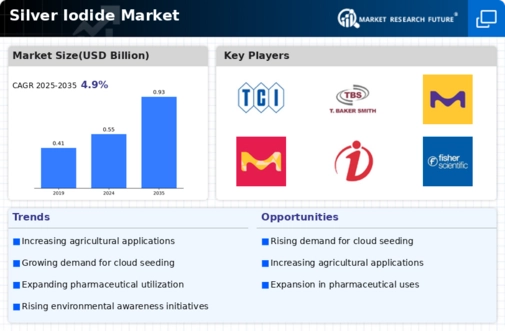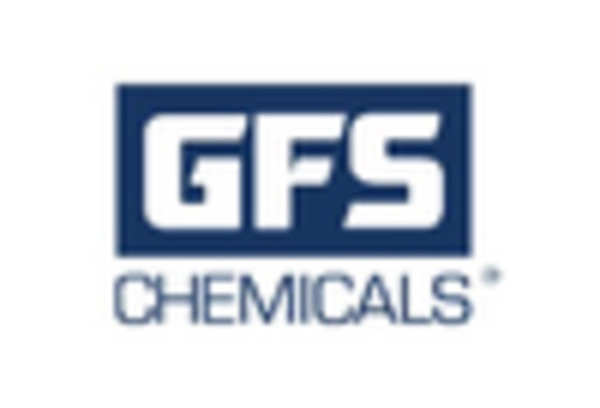The Silver Iodide Market is currently characterized by a dynamic competitive landscape, driven by increasing applications in cloud seeding, pharmaceuticals, and analytical chemistry. Key players such as GFS Chemicals (US), American Elements (US), and Merck KGaA (DE) are strategically positioned to leverage their technological capabilities and extensive distribution networks. GFS Chemicals (US) focuses on innovation in product development, particularly in enhancing the purity and efficacy of silver iodide for various applications. Meanwhile, American Elements (US) emphasizes regional expansion, targeting emerging markets where demand for silver iodide is on the rise, particularly in agricultural applications. Merck KGaA (DE) adopts a dual approach of digital transformation and sustainability, aiming to reduce its carbon footprint while enhancing product offerings, thereby shaping a competitive environment that prioritizes both innovation and environmental responsibility.
In terms of business tactics, companies are increasingly localizing manufacturing to reduce lead times and optimize supply chains. The Silver Iodide Market appears moderately fragmented, with several players vying for market share. However, the collective influence of major companies is significant, as they set industry standards and drive technological advancements. This competitive structure allows for a diverse range of products and services, catering to various customer needs across different sectors.
In August 2025, GFS Chemicals (US) announced the launch of a new line of high-purity silver iodide products specifically designed for pharmaceutical applications. This strategic move is likely to enhance their market position by catering to the stringent quality requirements of the pharmaceutical industry, thereby opening new revenue streams. The introduction of these products may also reinforce GFS Chemicals' commitment to innovation and quality, which could attract new clients seeking reliable suppliers.
In September 2025, American Elements (US) expanded its distribution network in Asia by partnering with local suppliers to enhance its market reach. This partnership is strategically important as it allows American Elements to tap into the growing demand for silver iodide in the region, particularly for agricultural and environmental applications. By localizing its supply chain, the company may improve its responsiveness to market changes and customer needs, thereby strengthening its competitive edge.
In July 2025, Merck KGaA (DE) unveiled a new sustainability initiative aimed at reducing waste in the production of silver iodide. This initiative not only aligns with global sustainability trends but also positions Merck KGaA as a leader in environmentally responsible manufacturing. The strategic importance of this move lies in its potential to attract environmentally conscious customers and partners, thereby enhancing the company's reputation and market share.
As of October 2025, the Silver Iodide Market is witnessing trends such as digitalization, sustainability, and the integration of artificial intelligence in production processes. Strategic alliances among key players are increasingly shaping the competitive landscape, fostering innovation and collaboration. Looking ahead, competitive differentiation is likely to evolve from traditional price-based competition to a focus on technological advancements, supply chain reliability, and sustainable practices. Companies that can effectively leverage these trends will likely secure a competitive advantage in the rapidly changing market.


















Leave a Comment